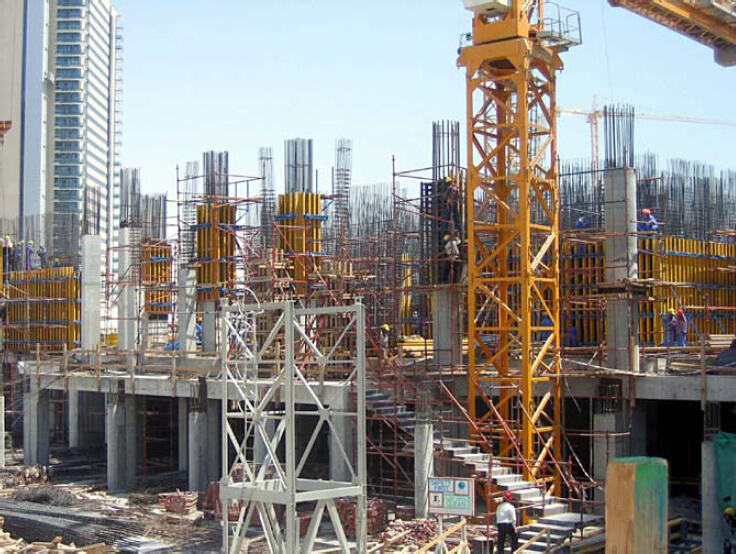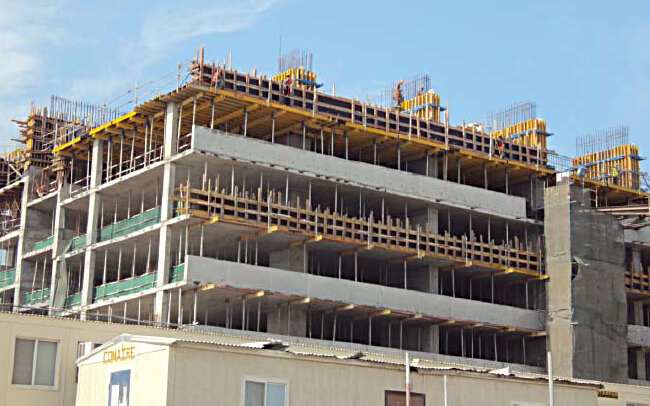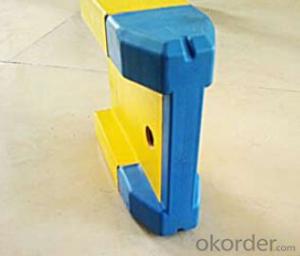Timber-Beam Formwork for building construction
- Loading Port:
- Tianjin
- Payment Terms:
- TT OR LC
- Min Order Qty:
- 50 m²
- Supply Capability:
- 1000 m²/month
OKorder Service Pledge
Quality Product, Order Online Tracking, Timely Delivery
OKorder Financial Service
Credit Rating, Credit Services, Credit Purchasing
You Might Also Like
Characteristics:
◆ Standardized production lines.
Supply capability: 3000m/day, Lmax = 6600mm.
◆ Finger jointing of the flange and web, the strength of timber beam is highly improved.
Max. shearing force failure load:40KN
◆ Well treated to prevent from water penetration or erosion, so the service life maximally
extended.
Normally, CNBM timber beam H20 can be used for 4 to 5 years, the exact using time would
depend on maintenance & storage.
◆ Robust caps at the end of the girders protect against damages.


- Q:How does steel formwork handle complex geometries?
- Construction projects can easily manage complex geometries using steel formwork, which is known for its versatility. Unlike traditional wooden formwork, steel formwork is custom-made to fit the project's specific requirements, allowing for the creation of intricate and complex shapes. Modular components are used to construct steel formwork, which can be assembled and adjusted to accommodate various geometric configurations. This flexibility enables it to handle challenging shapes like curves, arches, and irregular structures, which would be difficult to achieve with other types of formwork. In addition, steel formwork offers superior strength and stability, allowing it to withstand the pressure exerted by the concrete during pouring and curing. This strength enables the construction of tall and complex structures without compromising the integrity of the formwork system. Furthermore, steel formwork can be easily reused multiple times, making it a cost-effective solution for managing complex geometries. Its durability and resistance to wear and tear ensure that it can be used for numerous projects, further enhancing its economic viability. Moreover, steel formwork provides a smooth and consistent finish to the concrete surface, resulting in high-quality end products. This is especially important when dealing with complex geometries, as any imperfections or inconsistencies could be more noticeable. In conclusion, steel formwork is a reliable and efficient solution for managing complex geometries in construction. Its versatility, strength, reusability, and ability to provide a smooth finish make it an ideal choice for projects with intricate and challenging shapes.
- Q:Is steel formwork suitable for projects with high wind loads?
- Indeed, steel formwork proves itself as a suitable option for projects grappling with formidable wind loads. Renowned for its robustness, longevity, and steadfastness, steel formwork emerges as an exemplary selection for construction ventures besieged by elevated wind loads. By adeptly thwarting wind forces, steel formwork remains unyielding to deformation or harm in the face of tempestuous winds. Moreover, steel formwork guarantees an exceptional degree of dimensional precision, fortifying the structure against the exertions of wind while preserving its stability. Thus, steel formwork stands as a dependable and fitting choice for projects that confront formidable wind loads.
- Q:Can steel formwork be used for both slab and column construction?
- Both slab and column construction can utilize steel formwork. This type of formwork has numerous advantages compared to wood or plastic alternatives. Its durability allows it to endure the pressure exerted by fresh concrete, making it ideal for both slab and column construction. When used for slab construction, steel formwork provides a robust and rigid support system that ensures the concrete is poured and cured in the desired shape and dimensions. The steel panels are simple to assemble and disassemble, enabling efficient and repeated use on multiple projects. This ultimately saves both time and money in the long term. Likewise, steel formwork is suitable for column construction. The adjustable panels can be easily customized to accommodate various column sizes and shapes, offering design flexibility. Additionally, steel formwork provides a smooth surface finish, resulting in high-quality columns. Furthermore, steel formwork is resistant to warping, swelling, and shrinking, which are common issues with other types of formwork materials. This guarantees the accuracy and structural integrity of the concrete structure over time. In conclusion, steel formwork is a versatile and dependable choice for both slab and column construction. Its strength, durability, and user-friendliness have made it a favored option among construction professionals.
- Q:Can steel formwork be used for both residential and commercial construction projects?
- Yes, steel formwork can be used for both residential and commercial construction projects. Steel formwork is a versatile and durable option for creating concrete structures, including walls, columns, beams, and slabs. It offers several advantages such as high load-bearing capacity, dimensional accuracy, and reusability, making it suitable for various construction projects. In residential construction, steel formwork can be used for building foundations, retaining walls, and even for creating decorative elements. In commercial projects, it can be used for constructing office buildings, shopping malls, industrial facilities, and other large-scale structures. Additionally, steel formwork allows for faster construction and better quality control, resulting in time and cost savings for both residential and commercial projects.
- Q:Can steel formwork be used for both interior and exterior structures?
- Yes, steel formwork can be used for both interior and exterior structures. Steel formwork is versatile and can withstand various environmental conditions, making it suitable for both indoor and outdoor construction projects.
- Q:How does steel formwork handle different concrete reinforcement types?
- Steel formwork is an excellent choice for dealing with various types of concrete reinforcement due to its versatility and durability. It is commonly used in construction projects to create temporary molds or structures that hold concrete in place during the pouring and curing process. One of the benefits of steel formwork is its ability to handle different types of concrete reinforcement. Whether it's traditional reinforcement like steel bars or modern techniques such as fiber-reinforced polymers (FRP), steel formwork can accommodate them all. Steel formwork is specifically designed to be strong and rigid, enabling it to support the weight and pressure exerted by different reinforcement materials. It can withstand the forces exerted by steel bars or the tensile strength of FRP without experiencing any deformations or collapsing. Furthermore, steel formwork is highly adaptable and can be easily adjusted or modified to suit different reinforcement types. It can be cut or welded to create openings or recesses for steel bars or other materials to pass through. This flexibility guarantees that steel formwork can be tailored to meet the specific requirements of each construction project. Moreover, steel formwork provides a smooth and even surface finish, which is crucial for ensuring proper adhesion between the concrete and the reinforcement materials. This ensures that the reinforcement is securely embedded within the concrete structure, offering the necessary structural integrity and strength. To conclude, steel formwork is a dependable and efficient solution for managing different types of concrete reinforcement. Its strength, adaptability, and ability to provide a smooth surface finish make it an ideal choice for construction projects that necessitate diverse reinforcement materials.
- Q:How is steel formwork assembled?
- Steel formwork is assembled by first erecting vertical steel supports which are secured in place. Horizontal steel beams are then connected to the vertical supports to create a sturdy framework. Steel panels are then attached to the framework to form the desired shape of the concrete structure. Finally, the gaps and joints between the steel panels are sealed to ensure proper containment and support during the pouring of concrete.
- Q:Can steel formwork be used for both large and small construction projects?
- Yes, steel formwork can be used for both large and small construction projects. Steel formwork is highly versatile and can be adjusted to fit various project sizes. It offers durability, strength, and stability, making it suitable for both small-scale and large-scale construction projects.
- Q:What are the considerations when designing steel formwork for stairs?
- Several important considerations must be kept in mind when designing steel formwork for stairs. Firstly, it is crucial to carefully calculate and design the structural integrity and load-bearing capacity of the formwork. Stairs experience significant dynamic loads from people walking up and down, so the formwork must be able to support these loads without any deformation or failure. Accurately determining the dimensions and shape of the stairs is also essential to ensure a proper fit within the formwork. This involves considering the rise, tread, and overall dimensions of each step, as well as any landings or platforms that may be present. The formwork needs to be designed to accommodate these dimensions while providing a smooth and safe construction surface. The construction process and ease of installation should be taken into account as well. The steel formwork for stairs should be designed to be easily assembled, disassembled, and transported to the construction site. It should also allow for easy access during the construction process, ensuring that workers can safely and efficiently complete their tasks. Durability and longevity are crucial factors when designing steel formwork for stairs. While steel is a strong and durable material, it is important to consider the potential for corrosion and wear over time. The design should incorporate proper coatings and protective measures to prevent corrosion and ensure the formwork's longevity. Finally, safety is of utmost importance when designing steel formwork for stairs. The formwork should be designed to provide a secure and stable working platform for construction workers. This may involve incorporating handrails, non-slip surfaces, and other safety features to minimize the risk of accidents or falls during construction. In conclusion, when designing steel formwork for stairs, it is important to consider factors such as structural integrity, dimensions, ease of installation, durability, and safety. By carefully considering these factors, a well-designed steel formwork system can be created to efficiently and effectively construct stairs in a safe and reliable manner.
- Q:How does steel formwork handle different concrete surface preparation techniques?
- Steel formwork proves to be a flexible and long-lasting solution for concrete construction endeavors, effortlessly accommodating diverse techniques for preparing concrete surfaces. Whether a sleek, blemish-free finish is desired or a rough texture is preferred, steel formwork can easily adapt. For achieving smooth finishes, steel formwork provides a sturdy and level surface, enabling precise leveling and alignment. The steel panels are meticulously designed to be seamless and flawless, guaranteeing a uniform concrete surface devoid of imperfections. This proves particularly advantageous for projects requiring a superior finish, such as architectural structures or decorative elements. Conversely, if a rough texture is the objective, steel formwork can effortlessly accommodate a variety of techniques to achieve the desired outcome. The formwork can be modified to incorporate patterns or textures such as wood grain or stone-like finishes, accomplished through the use of specialized liners or inserts. These liners can be affixed to the steel panels, imparting the desired texture onto the concrete surface. Furthermore, steel formwork adeptly handles other concrete surface preparation techniques such as shot blasting or acid etching. Shot blasting involves propelling steel balls onto the concrete surface, effectively eliminating contaminants and creating a rough texture. Acid etching entails the application of acidic solutions to the concrete, inducing a chemical reaction that eliminates a thin layer from the surface, thereby resulting in a textured finish. Steel formwork can withstand the impacts of shot blasting and the corrosive effects of acid etching without sustaining damage. Moreover, steel formwork offers remarkable adaptability, effortlessly customizable to meet specific project requirements. Should a particular surface preparation technique be necessary, the steel formwork can be designed accordingly to accommodate it. This versatility facilitates the achievement of a wide array of concrete surface finishes through the utilization of steel formwork. In conclusion, steel formwork is capable of accommodating various concrete surface preparation techniques, whether for smooth finishes, rough textures, or any other specific requirements. Its versatility, durability, and adaptability render it an exceptional choice for concrete construction projects that demand diverse surface finishes.
1. Manufacturer Overview |
|
|---|---|
| Location | |
| Year Established | |
| Annual Output Value | |
| Main Markets | |
| Company Certifications | |
2. Manufacturer Certificates |
|
|---|---|
| a) Certification Name | |
| Range | |
| Reference | |
| Validity Period | |
3. Manufacturer Capability |
|
|---|---|
| a)Trade Capacity | |
| Nearest Port | |
| Export Percentage | |
| No.of Employees in Trade Department | |
| Language Spoken: | |
| b)Factory Information | |
| Factory Size: | |
| No. of Production Lines | |
| Contract Manufacturing | |
| Product Price Range | |
Send your message to us
Timber-Beam Formwork for building construction
- Loading Port:
- Tianjin
- Payment Terms:
- TT OR LC
- Min Order Qty:
- 50 m²
- Supply Capability:
- 1000 m²/month
OKorder Service Pledge
Quality Product, Order Online Tracking, Timely Delivery
OKorder Financial Service
Credit Rating, Credit Services, Credit Purchasing
Similar products
New products
Hot products
























